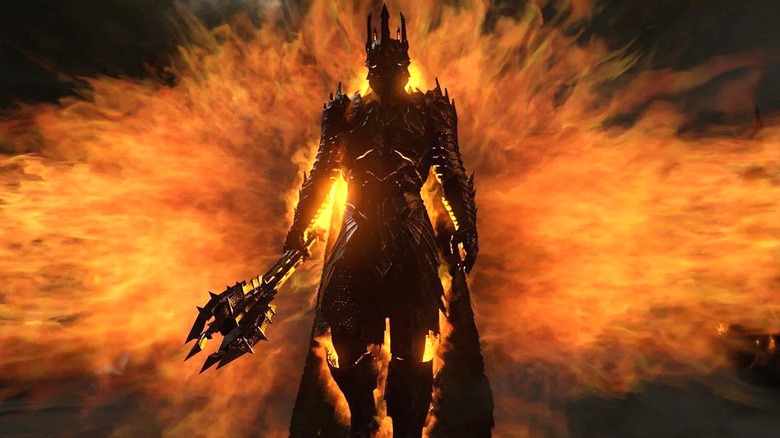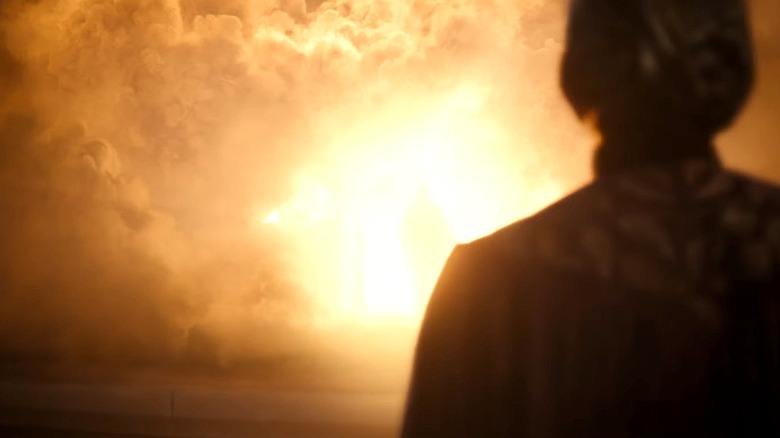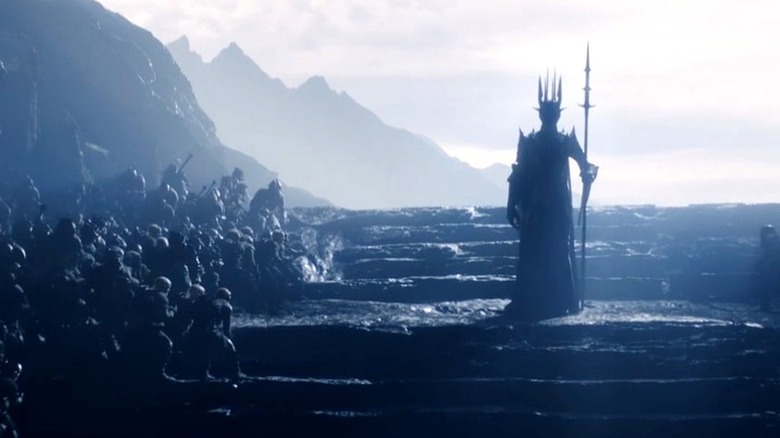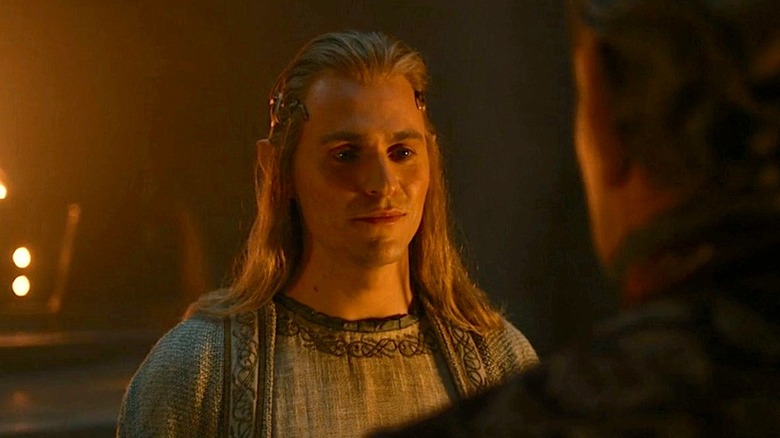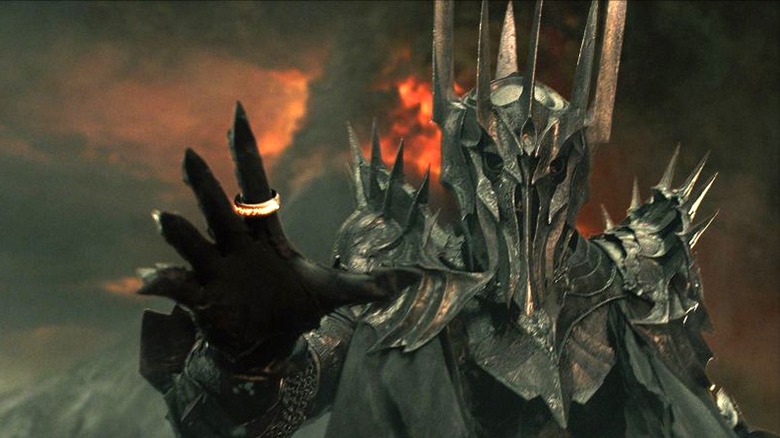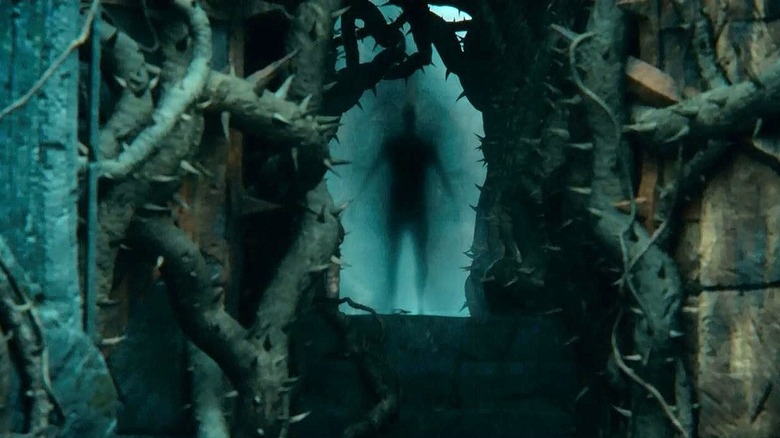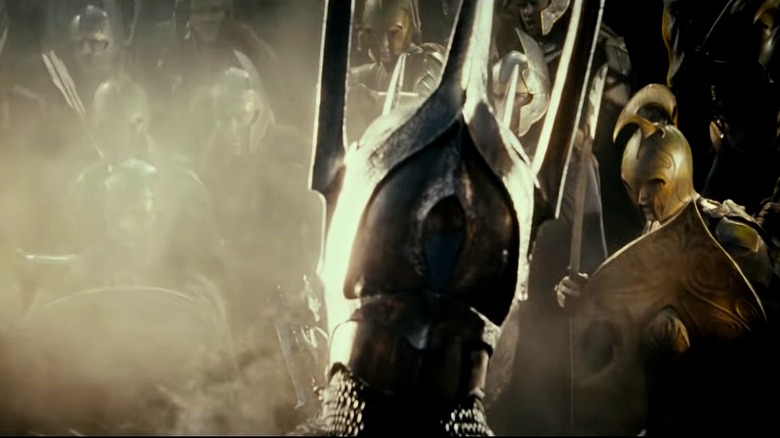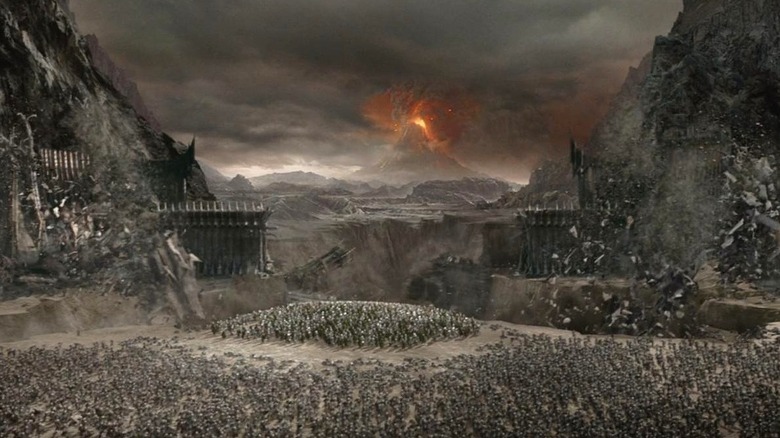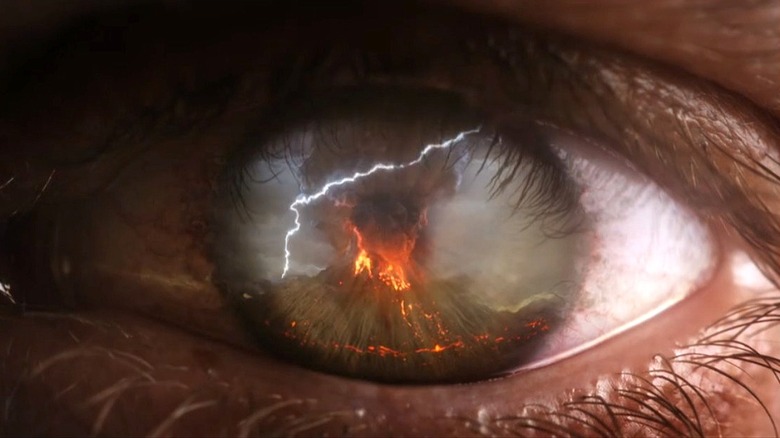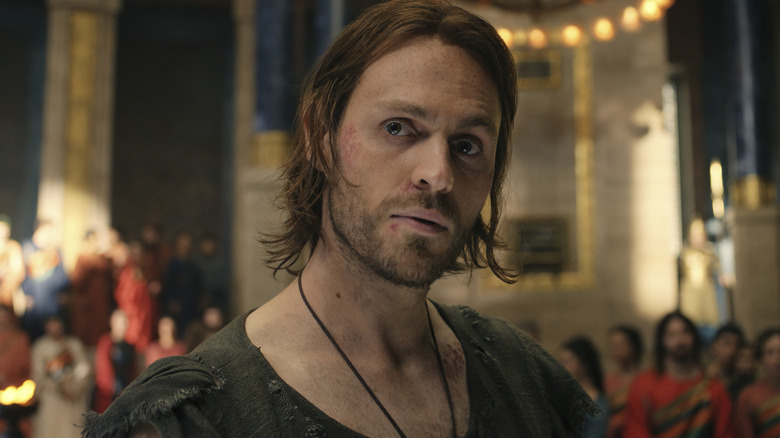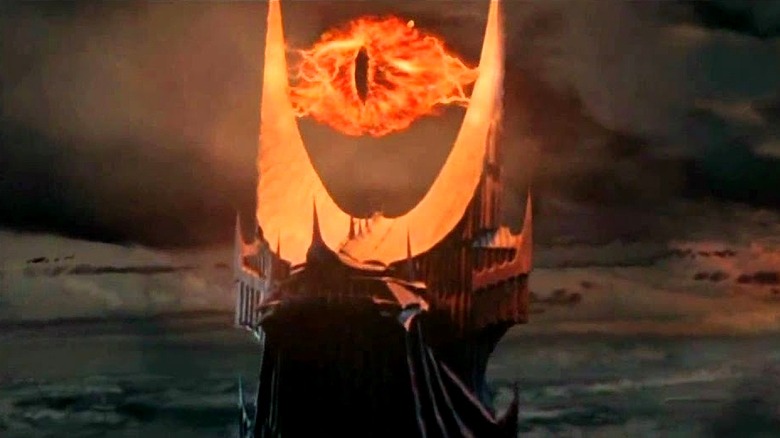Every Form Of Sauron In Chronological Order, Explained
Sauron is a fascinating villain, if only because he shows up in so many different forms throughout J.R.R. Tolkien's world. Sure, by the time of "The Lord of the Rings," he's relatively a straightforward character with a purely evil, titanic off-screen presence that we meet primarily through his servants. But the Dark Lord has a long and complicated history before that point of supreme power.
There are glimpses of this in different adaptations. Early in Peter Jackson's trilogy, we see Sauron as a towering figure clad in armor. We also see his guise as the Necromancer in "The Hobbit" trilogy. Prime Video's "The Rings of Power" series has shown us multiple interesting personas from the Dark Lord's history, too.
Part of the complexity of Sauron's colorful visual history comes from his ability to shape-shift, a trait that Tolkien makes clear doesn't work like Mystique from the X-Men. Sure, at times, taking on a physical form is a relatively easy task for individuals in Tolkien's writings, but it isn't a flashy superhero power you can turn on and off at will. Often, the process of shape-shifting is described as laborious, limiting, and time-intensive. The beginning of Season 2 of "Rings of Power" even gave us some creative insights into what it might look like for a Maiar (the angelic race of beings that Sauron hails from) to take on a new physical form after their body dies more than once. While showrunners JD Payne and Patrick McKay's version of this process was made up for the show (there isn't really much about what it looks like in the books), it gets the point across: it isn't easy or fun.
After a while, all of Sauron's different forms tend to flow together. From fair forms to terrifying armor-clad figures to ghostly apparitions and glowing eyeballs, let's sort this guy's physical manifestations out, shall we? Here is every spiritual and incarnate form of Sauron in chronological order from his beginning to the last moment we see him in Tolkien's writings — along with a few alternative versions of the character (both from Tolkien and other creatives) just to spice things up.
Sauron's original, unfallen form
In the beginning, Sauron was one of the Ainur. These are a spiritual race of heavenly beings that exist outside of time and space before the world is created. Tolkien talks about them in the earliest pages of "The Silmarillion," saying, "There was Eru, the One, who in Arda is called Ilúvatar; and he made first the Ainur, the Holy Ones, that were the offspring of his thought, and they were with him before aught else was made." In other words, Sauron comes straight from the brain of the Creator.
Together, Ilúvatar and the Ainur write a mighty symphony, which functions as a musical outline of history. After this, the One creates the world, and some of the Ainur descend into it — including Sauron. The leaders of these Ainur are called the Valar, while the rest are referred to as the Maiar. Sauron is one of those Maiar.
It's also worth mentioning that there is a single reference in an edition of a linguistic journal called Parma Eldalamberon claiming that, in these early days, Sauron was called Mairon, although there is no other Tolkien-written evidence backing that up from what we can find. Regardless of his name, Sauron starts as an innocent, wide-eyed Maiar who enters the world in spiritual form. While he can take shape if he wants to, Tolkien refers to physical bodies as a kind of "clothing" for the Ainur — something they could take or leave without affecting their real forms. For the Dark Lord in waiting, though, this is a reality that won't last.
Sauron, Morgoth's lieutenant
When the original Dark Lord, Morgoth, breaks bad, he seduces Sauron to his allegiance, making him one of his greatest, most trusted, and most perilous servants. Part of this sinister reputation is specifically attributed to the fact that Sauron could take on many forms, both of an attractive and less attractive nature. "The Silmarillion" describes him at this point, saying, "Sauron was become now a sorcerer of dreadful power, master of shadows and of phantoms, foul in wisdom, cruel in strength, misshaping what he touched, twisting what he ruled, lord of werewolves; his dominion was torment."
Sauron's shape-shifting also reaches peak performance in his new position as lieutenant to Middle-earth's top baddie. When he has a run-in with Tolkien's famous power couple, Beren and Luthien, the Dark Lord takes on the form of a wolf and has an epic duel with a mythical hound, and when the canine captures him in its jaws, he tries shape-shifting to escape. The text lists several forms he assumes, saying, "Sauron shifted shape, from wolf to serpent, and from monster to his own accustomed form." He ends up escaping in a bat-shaped vampiric form.
So, basically, at this early stage in his villainous career, Sauron is in a terrifying embodied form, and he can rapidly change from one shape to another. At the end of the First Age, he shifts back to a fair form in an attempt to placate the enemies of Morgoth after they defeat his master. He's still in the later stages of this period of life when we meet him in "The Rings of Power," too. This explains why, within two seasons, we've seen the Dark Lord as a figure cloaked in mysterious armor, as a human played by multiple actors in two different forms, and, finally, as another of his hallmark personas: Annatar, Lord of Gifts.
Sauron as Annatar, Lord of Gifts
Everyone knows Sauron as the terrifying warlord. But one of his most interesting and infamous guises is as Annatar, Lord of Gifts. This is a fair form that the Dark Lord dons in the middle of the Second Age of Middle-earth to weasel his way into the affections of the then-powerful Elven kingdoms in Middle-earth. "The Silmarillion" says that he goes far and wide amongst the Elves. The only place he avoids is the powerful kingdom of Lindon, where the High King Gil-galad and Elrond are suspicious of this wandering do-gooder and his empty platitudes and unsolicited promises of help.
We don't get too much description here, but the book does say, "[H]e went far and wide among them, and his hue was still that of one both fair and wise." In this attractive form, Sauron convinces the Elves to forge Rings of Power before forging his one Master Ring that he uses to try to control the others.
Sauron the terrifying
Once Sauron has forged the One Ring, he tries to conquer Middle-earth by force. This leads to his surrender (willingly) to the Human forces of Númenór, after which he repeats his Annatar schtick by worming his way into the affections of Númenor's king, Ar-Pharzôn. Long story short, Sauron helps precipitate the downfall of that island kingdom, but he loses his own physical body in the process. His spirit flees back to the Mordor on the mainland, and, "The Silmarillion" explains, "there now he brooded in the dark, until he had wrought for himself a new shape; and it was terrible, for his fair semblance had departed for ever when he was cast into the abyss at the drowning of Númenor."
Tolkien describes this new shape as clothed in power, and this is one of the first times that we get a reference to the Eye of Sauron as an upper-case, proper noun. But it's important to realize that he's more than just an eye. He is a fully formed figure with a spine-chilling gaze.
This is the tall and intimidating new form that we meet in the opening sequence of Peter Jackson's "The Fellowship of the Ring" movie. In a letter written in 1963, Tolkien added more vague descriptives to this version of the Dark Lord, saying, "Sauron should be thought of as very terrible. The form that he took was that of a man of more than human stature, but not gigantic." This is his form for a bit, but ultimately, he loses it once again when Isildur cuts the Ruling Ring from his finger.
Sauron as The Necromancer
After he loses two bodies and the One Ring, it takes a long time for Sauron to assume a new form, and when he does, it's one of the creepiest ones to date. He doesn't appear as a hunky Elf-like Lord of Gifts or a terrifying warrior. He takes on a ghoulish shape called "the Necromancer." This is the outward condition that he is in when he crosses over into "The Hobbit" story. However, he's only briefly mentioned in that narrative as a distant and horrifying threat.
We don't get much about his actual look during this period of his life. But the appendices of "The Return of the King" point out that when he first sets up shop at his new stronghold of Dol Guldur in southern Mirkwood early in the Third Age, the Wise (a special council with members like Gandalf, Elrond, and Galadriel) believe he is one of the Ringwraiths. Based on the descriptions of the Black Riders, this seems to imply that he maintains a very otherworldly, invisible, or ghost-like appearance, though this isn't explicitly stated. It takes another millennium for them to start to realize that it's actually Sauron taking shape again.
Sauron in The Lord of the Rings
Once we reach "The Lord of the Rings" story, Sauron has shed his Necromancer persona and moved back to Mordor. He's the top dog Dark Lord again — but does he have a body? Peter Jackson has conditioned Middle-earth fans to believe that he has a physical form, but it's a single, ocular portion of a body, namely the Eye of Sauron. (More on this in a minute.) The truth is, while Tolkien does emphasize Sauron's piercing gaze and ocular organ, he never says that Sauron exists as an eyeball at any point in his long career of villainy. Instead, Sauron simply remains mysterious and out of sight.
Still, we hear about one other body part besides his eye. At one point in "The Two Towers," Gollum makes a reference to Sauron's "Black Hand," indicating that he's seen someone with an actual appendage. Interestingly, Gollum adds that this hand only has four fingers, which implies Sauron is still missing his ring finger.
This isn't explained further, but according to our research, there are two likely possible explanations here. The first is that Sauron forms a hand with four fingers on purpose as a reminder of his hatred toward Isildur and his descendants (including Aragorn). The other is that he has poured so much of his power out into ring-making and the domination of wills that he simply can't take on a unique new form at this point. His previous master, Morgoth, has a similar trajectory in the sense that he invests so much power into his evil creations and deeds that he becomes bound to his physical body. Perhaps by this point, Sauron is similarly restricted to a limited earthly form. One thing is for sure. When Sauron loses the power of the One Ring, he loses his ability to take any incarnate form whatsoever.
Sauron after The Lord of the Rings
Sauron doesn't die in "The Lord of the Rings," despite Peter Jackson showing the Dark Lord's eye pop like a firework. When the One Ring is destroyed in the books, Tolkien gave us the less flashy but more ominous line, "There rose a huge shape of shadow, impenetrable, lighting-crowned, filling all the sky. Enormous it reared above the world, and stretched out towards them a vast threatening hand, terrible but impotent: for even as it leaned over then, a great wind took it, and it was all blown away, and passed; and then a hush fell."
In either case, even though it's tempting to think that the Dark Lord has died at this point, in reality Sauron's true fate is worse than death. Earlier in "The Return of the King" book, Gandalf explains what will happen to Sauron if the One Ring is destroyed, saying, "[Sauron] will lose the best part of the strength that was native to him in his beginning, and all that was made or begun with that power will crumble." The Wizard concludes, "he will be maimed for ever, becoming a mere spirit of malice that gnaws itself in the shadows, but cannot again grow or take shape."
Technically speaking, "The Silmarillion" adds that Sauron follows his master into "The Void" — that is, an empty area outside of time and space, where he remains in meaningless existence for eternity. Either way, one thing is pretty clear. He doesn't take another known physical form.
Sauron — Prince of Cats?
Okay, so we've traced the canon forms of Sauron straight through from his beginning to his end, but he actually has even more forms than these. For starters, Tolkien created multiple iterations of the Dark Lord before he settled on the Sauron persona. An early version of "The Silmarillion" titled "The Book of Lost Tales" features a primitive version of Sauron called Tevildo Prince of Cats — and yes, along with leading them, he himself is a cat in this instance. He is described as the mightiest of all cats, in fact, and one that was possessed by an evil sprite.
There are entire stories with Tevildo, and it is semi-convincing stuff, but the entire time it smacks of some oversized ruckus that could have taken place in the backyard. There's no doubt that Sauron is an upgrade.
However, Tolkien didn't jump straight from Tevildo to Sauron. First, he reworked the feline villain to be Thû, a nasty necromancer who is the Lord of Werewolves. (Clearly, Tolkien couldn't get away from the cat and dog theme, here.) Ultimately, the author changed things up yet again, jumping from Thû to the one and only Sauron, and the rest is Middle-earth history.
Sauron as a Southern King
Up until now, everything we've talked about has in some way connected to Tolkien's original vision (or visions) for Sauron. From Tevildo, Prince of Cats to Gorthaur the Cruel to Annatar, Lord of Gifts, the Oxford Professor wasn't afraid to present Sauron as a complicated, multi-faceted villain with plenty of different appearances and personas. That said, in the 21st century, we've also been treated to multiple new, off-page iterations of the bad guy.
The most recent of these is Halbrand, as played by Charlie Vickers in Prime Video's "The Lord of the Rings: The Rings of Power" series. In Season 1, Sauron appears as a misplaced mortal king of the Southlands. He uses this guise to befriend Galadriel and spark the creation of Mordor and of Rings of Power. In the end, Halbrand is exposed, and Sauron has to rework his lie into the less hunky and more intoxicating immortal Annatar.
Halbrand is fun, but he is definitely not a Tolkien original. Sauron never takes on a known mortal form in the source material, let alone anyone named Halbrand. Even when he spreads his lies amongst the tribes and nations of Men in Rhûn, Harad, Khand, and other southern and eastern portions of Middle-earth, he positions himself as a god, not as a mortal. It is a pure invention of the show to have him pretending to be a Human while masquerading around Middle-earth early in the Second Age.
The closest thing we get to an explanation for Halbrand is in "Unfinished Tales," where, before the whole Annatar ring-making adventure, the book says, "Sauron had as yet no single name, and his operations had not been perceived to proceed from a single evil spirit." Clearly, showrunners JD Payne and Patrick McKay took this vague description and decided to fill in the gaps (something that they have had to do early and often to beef up Tolkien's thin Second Age source material for their story). The result of this creative license is Halbrand, a new and interesting form of Sauron — though he is admittedly inferior to the more canon-accurate Annatar version of Vicker's character that we've gotten in Season 2.
Sauron as an Eyeball
The other interesting modern adaptation is one we already touched on earlier. Peter Jackson's eyeball-shaped Sauron is a fascinating take on the "Lord of the Rings" villain. Technically speaking, this Sauron does appear in the books; however, Jackson's take on Sauron's form during the War of the Ring is utterly unique — and a bit out of left field.
Tolkien repeatedly refers to the Eye of Sauron as a roving force seeking the One Ring. It shows up when Frodo looks into the Mirror of Galadriel and again when he sits on the Seat of Seeing on Amon Hen after Boromir tries to take the Ring. When the Hobbits travel through Mordor, Tolkien mentions the "Window of the Eye" in Barad-dûr. Frodo also talks about seeing the "Wheel of Fire" in his mind and at one point sees a distant, flickering flame of red atop Sauron's tower, which is described as a "piercing Eye."
So, the references are there. We get it. But Sauron is never described as having taken the form of an actual eye. Remember, Gollum talks about his four-fingered hand — the guy has a body, folks. His eye is just its most prominent feature. Ironically, this odd visualization of the Dark Lord as a glowing, stationary, spot-light-like eyeball is the one that has come to be the most closely associated with the Dark Lord. This restrictive, semi-pathetic form is the thing everyone thinks about when Sauron's name is mentioned, even though, by this point, the Dark Lord has a long history of terrifying, intimidating, alluring, and otherwise awe-inspiring forms that make him a much more complex villain and one of the greatest ever created.
